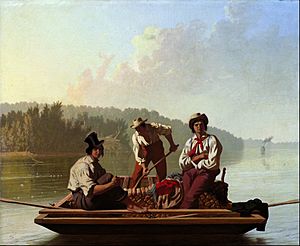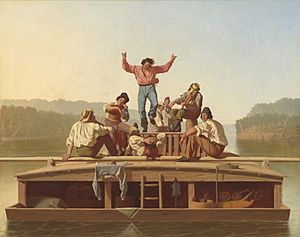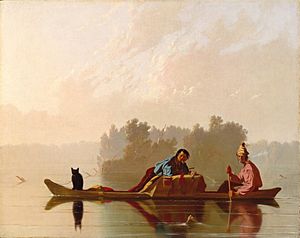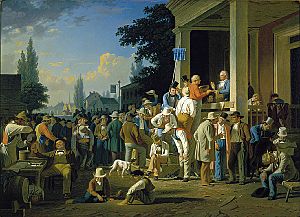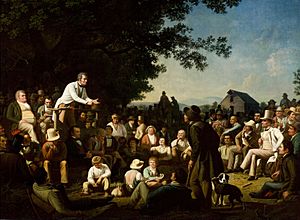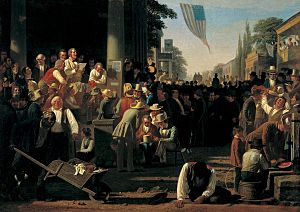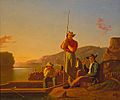George Caleb Bingham facts for kids
Quick facts for kids
George Caleb Bingham
|
|
|---|---|
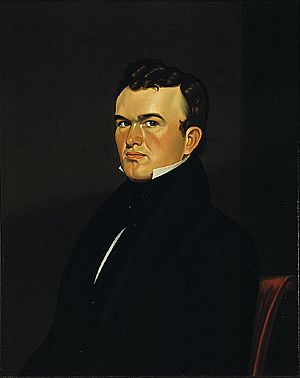
A self-portrait by George Caleb Bingham, painted 1834–35
|
|
| Born | March 20, 1811 |
| Died | July 7, 1879 (aged 68) |
| Nationality | American |
| Education | Autodidact (study of prints of Old Masters and copybooks) Pennsylvania Academy of Fine Arts |
| Known for | Painting |
| Movement | Luminism |
George Caleb Bingham (born March 20, 1811 – died July 7, 1879) was a famous American artist, soldier, and politician. People called him "the Missouri Artist" during his lifetime.
He was first a member of the Whig Party. He was chosen to be a representative in the Missouri government before the American Civil War. There, he worked to stop the spread of slavery into new western territories.
During the Civil War, even though he was born in Virginia, Bingham strongly supported the Union. He became a captain in a volunteer group that helped keep Missouri from joining the Confederacy. After that, he served four years as Missouri's Treasurer.
In his later years, Bingham held several important jobs in Kansas City. He also served as Missouri's Adjutant General. His paintings show what life was like on the American frontier along the Missouri River. His art style is known as Luminism, which focuses on light and calm scenes.
Contents
Early Life and Learning to Paint
George Caleb Bingham was born on a farm in Augusta County, Virginia. He was the second of seven children. His family moved to Franklin, Missouri, in 1819. This town was on the Missouri River and near the start of the Santa Fe Trail. They hoped to find good, cheap land there.
George's mother first taught him at home. He learned to paint mostly by himself. When he was nine, a famous portrait painter named Chester Harding visited Franklin. George helped Harding, and this experience made a big impression on him.
In 1823, when George was twelve, his father died from malaria. His family faced financial difficulties. George worked as a janitor at a school his mother opened. He also received some art lessons from a teacher there.
At age sixteen, Bingham became an apprentice to a cabinet maker in Boonville. He later worked with another cabinet maker. Both of these men were Methodist ministers. During this time, Bingham studied religious books and thought about becoming a minister himself. He also considered becoming a lawyer.
By the time he was nineteen, Bingham was painting portraits for money. He often finished a painting in just one day. He became known for capturing people's likenesses well. By 1833, he was able to support himself with his art. He planned to travel to St. Louis for work but got measles, which left him weak and caused him to lose his hair permanently.
By 1838, Bingham had his own art studio in St. Louis. He started to become known as a portrait artist. Important local people, like lawyer James S. Rollins, visited his studio. Rollins became a lifelong friend and a powerful politician. Even though Bingham often worked in St. Louis, he kept his main home in Arrow Rock for many years.
Bingham then decided to get more formal art training. He moved to Philadelphia, Pennsylvania, with his first wife. He spent three years studying art at the Pennsylvania Academy of the Fine Arts. He also visited an art exhibition in New York City. After that, Bingham lived in Washington, D.C., for almost five years. There, he painted portraits of many politicians, including former president John Quincy Adams.
Family Life
In 1836, George Caleb Bingham, who was 25, married Sarah Elizabeth Hutchison, who was 18. They had four children together. From 1837 to 1845, they lived in Arrow Rock. Their house there is now a National Historic Landmark. Sarah died in 1848 when she was only twenty-nine years old. Bingham's mother, Mary, helped him raise his children until she passed away in 1851.
Bingham married two more times. His second wife was Eliza K. Thomas. After several years, she needed care in a hospital for mental health, where she died in 1876. He then married Martha Lykins, a widow who was known for helping orphans in Kansas City. However, their marriage lasted less than a year before Bingham died.
Career in St. Louis and Europe
Bingham and his family moved back to St. Louis for good in 1845. His painting, "Jolly Flatboatmen," became very popular. An organization called the American Art Union helped share copies of his work with many people.
Because of his success, Bingham decided to run for election as a Whig to the Missouri House of Representatives in 1846. He seemed to have won, but a recount showed he lost. In 1848, he ran again and won by a clear margin. This made him one of the few artists to be elected to a political office. He spoke out against laws that supported slavery. Bingham's interest in politics can be seen in his lively paintings of frontier political life.
In 1856, Bingham traveled to Europe with his second wife, Eliza, and his youngest daughter. They stayed in Paris for several months. Bingham had always wanted to study the works of Old Masters at the Louvre Museum, and he did so. Then they moved to Düsseldorf, Germany, and lived there until 1859. Bingham joined an art community there with American and German artists. He worked on important paintings, including commissions from the Missouri government.
During the American Civil War
Bingham returned to America in 1859. He continued to travel around Missouri, painting portraits and getting involved in politics again. In the 1860 election, Missouri elected Claiborne Fox Jackson as governor. Jackson said he was against states leaving the Union. However, after Abraham Lincoln was elected president, Jackson started talking with Confederate leaders.
Bingham was a strong supporter of the Union. He gathered troops to oppose Governor Jackson and was made a captain. Union forces defeated the Confederates in battles at Boonville in 1861. The Missouri Convention decided against leaving the Union and replaced Governor Jackson.
In September 1861, Bingham was appointed State Treasurer of Missouri. He served honestly throughout the war. In 1863, Bingham strongly disagreed with Order No. 11 issued by Union General Ewing. This order forced people to leave their homes in several western Missouri counties to stop support for Confederate fighters. Bingham believed this order was cruel and made things worse. He even painted a famous picture about this order later. During this time, Bingham also continued to paint portraits, which helped him earn a living.
After the War
After the American Civil War, Bingham continued to be involved in politics. He joined the Democratic Party. In 1874, he became the president of the Kansas City Board of Police Commissioners. He also appointed the city's first chief of police. In 1875, the governor made Bingham the Adjutant-General of Missouri, which is why people often called him "General Bingham."
Near the end of his life, even though he was very ill, Bingham was appointed the first Professor of Art at the University of Missouri in Columbia, Missouri. He taught a few students before he passed away.
Death and Legacy
George Caleb Bingham died on July 7, 1879, in Kansas City, Missouri. He was buried at Kansas City's Union Cemetery.
For a while after his death, Bingham's art was not as well-known. But in 1933, his reputation grew again. Another Missouri artist, Thomas Hart Benton, recognized Bingham's importance. The Metropolitan Museum of Art bought one of his early famous works, "Fur Traders Descending the Missouri." In 1934, the St. Louis Art Museum held a special exhibition of his work. People started to notice his paintings of everyday people from the mid-1800s.
By 2011, which was 200 years after his birth, Bingham was seen as one of the greatest American painters of the 19th century. New paintings by Bingham have been discovered and confirmed since then.
Honors for George Caleb Bingham include:
- The University of Missouri has named the George Caleb Bingham Art Gallery in his honor.
- George Caleb Bingham Middle School in Independence, Missouri, is named after him. He served on the Independence Public School District Board of Education.
Famous Paintings
Fur Traders Descending the Missouri
This is one of Bingham's most famous paintings. It is owned by the Metropolitan Museum of Art in New York. He painted it around 1845. Some art historians call its style luminism.
The painting was first called French Trader, Half-breed Son. The American Art Union thought this title might cause problems, so they changed it when the painting was first shown. The painting shows the real-life situation where fur trappers often married Native American women. The painting creates a feeling of a past time in American history. You can see a black fox in the front of the boat, held by a chain.
The Election Series
Bingham created a series of three paintings about elections: The County Election, Stump Speaking, and The Verdict of the People. Bingham wanted these paintings to be seen by people all over the country, not just in Missouri. He showed them in Washington, D.C., hoping Congress would buy them. When they didn't, he lent them to a library in St. Louis.
The County Election
The first painting in the Election Series shows how voting happened in Missouri. The County Election shows many different kinds of people. There are young boys playing, men talking about the election, and a crowd of men going up stairs to vote.
A banner in the painting says, "The Will of the People[,] The Supreme Law." This idea was very important to Bingham. He believed that people should have the right to share their ideas. He also felt that he lost his election in 1846 because people's will was not followed correctly.
The painting takes place outdoors to show that politics should be open for everyone to see. Bingham believed that every white man should have the right to vote. This idea supported his belief that the will of the people should be the highest law.
Some critics thought the painting made fun of American principles. They pointed to details like a man who appears to be drinking too much. They said that showing drinking and gambling in an election scene was disrespectful to the political process.
To make the painting's message more general for the whole country, Bingham made some changes in later versions. For example, he removed two men flipping a coin, which was a specific reference to a Missouri bet. He also asked for a newspaper title in the painting to be changed from "The Missouri Republican" to "The National Intelligencer."
Stump Speaking
In the second painting of the series, Stump Speaking, a politician tries to convince Missourians to vote for him. Three figures stand out because they wear bright white clothes: the "Stump Speaker," the "Outstanding Citizen" (a man sitting across from the speaker), and the "Small Businessman" (a young child in the middle).
Bingham made early sketches of these three people. They represent his ideas about the past, present, and future of American politics. The "Outstanding Citizen" represents the past. His sharp features and nice clothes show he sticks to his beliefs. The "Stump Speaker" represents the present. He seems to be winning over the crowd by agreeing with what people want. The "Small Businessman" represents the future. This child shows how people might start focusing more on money and less on politics.
Bingham included both national and local messages in Stump Speaking. Some people in the painting look like real Missouri politicians. Behind the speaker, a man who looks like Bingham himself is taking notes, waiting for his turn to speak. The "Stump Speaker" looks like Sappington, who was Bingham's opponent in past elections.
The Verdict of the People
The Verdict of the People is the last painting in Bingham's Election Series. It shows the end of the story. Completed in 1854, this painting deals with important issues like slavery, temperance (avoiding alcohol), and representative government. These topics were becoming important across the country.
In the early 1850s, the temperance movement grew, and more states were banning alcohol. Some people connected the fight against alcohol to the fight against slavery. Bingham showed his views on these issues with a banner that said, "Freedom for Virtue[,] Restriction for Vice." This banner suggested that bad habits like drinking needed to be controlled for people to be truly free. By linking temperance and anti-slavery, Bingham showed his negative view of slavery.
Images for kids
-
Portrait of Vinnie Ream, 1876
See also
 In Spanish: George Caleb Bingham para niños
In Spanish: George Caleb Bingham para niños


